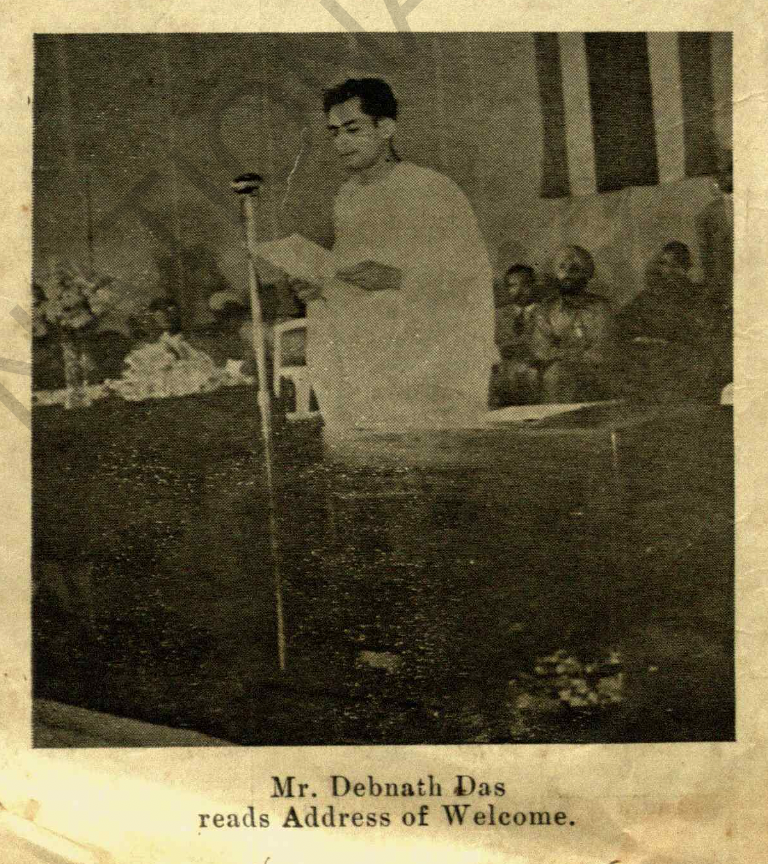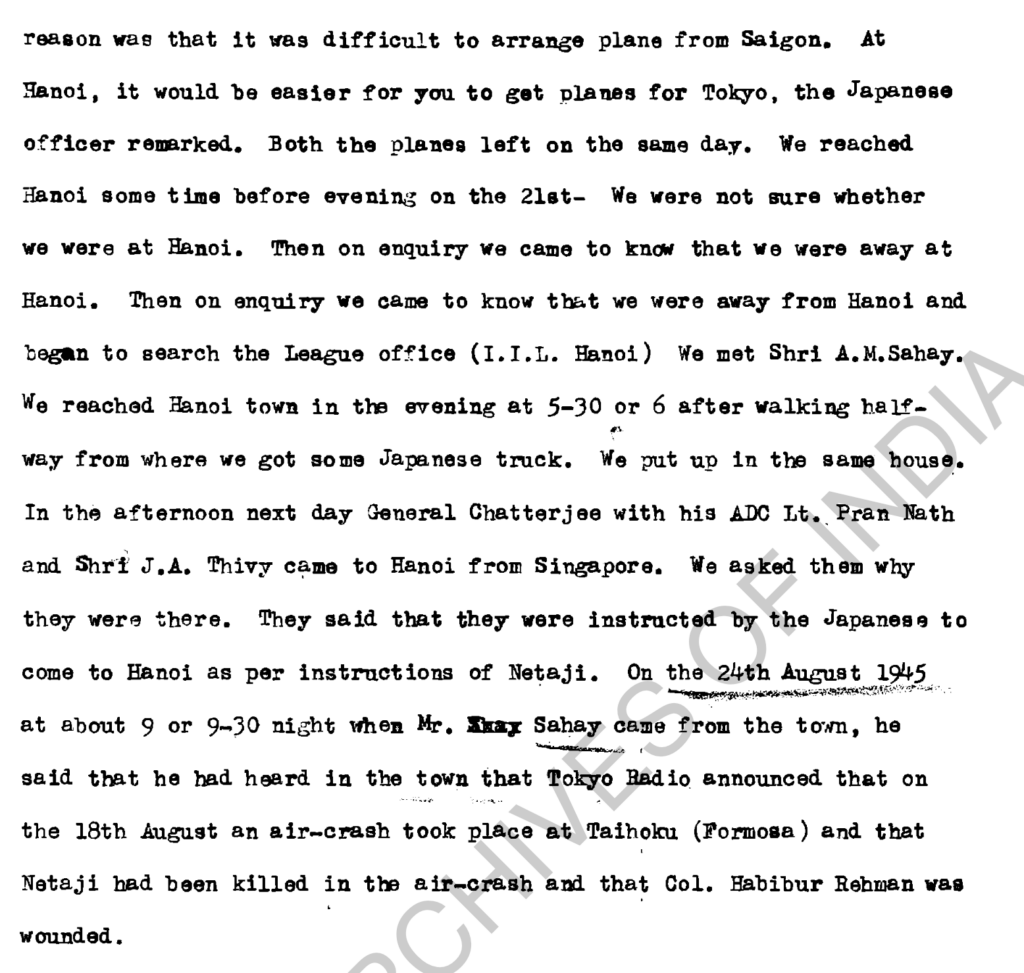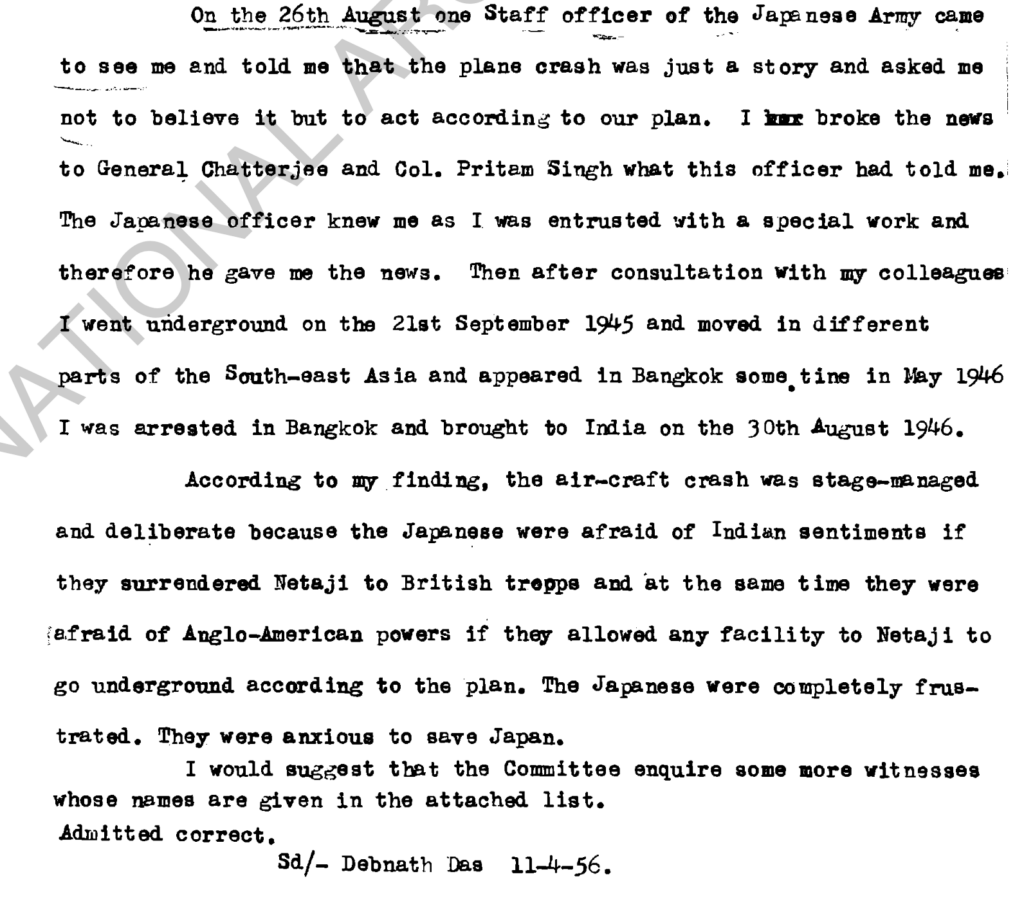
Debnath Das was a close associate of Anand Mohan Sahay in Japan. He is mentioned frequently in Sahay’s memoir Stirring Times and is also mentioned by Lt Bharati ‘Asha’ Sahay in her diary as “Das Kaka”.
Prior to his arrival in Thailand, he was in Japan and worked closely with Sahay and Rash Bihari Bose. In Stirring Times, Sahay mentions: “Mr Bose and I decided to send Debnath Das to Bangkok to establish contact and prepare the ground for our future base there.”
I’m sharing the statement which he tendered to the Shah Nawaz Committee on April 5, 1956 in Calcutta.
Statement by Debnath Das
I was Chairman of the Reception Committee of the First Indian Independence Conference in East Asia that was held from 15th June 1942 to 22nd June 1942 in Bangkok. Before the Conference was held, I was General Secretary of the Indian National Council for Freedom of India in Thailand soon after the Japanese came, and after the Bangkok Conference when the constitution of the Indian Independence League was formed, according to the Constitution, I was elected as the Chairman of the Territorial Committee of Thailand and continued in that post till the arrival of Netaji on the 4th July 1943.

When Netaji took charge of the I.I.L. Headquarters at Singapore on the 5th July 1943, I was General Secretary of the I.I.L. Headquarters, East Asia and was stationed at Rangoon. When the Provisional Government of Azad Hind was formed on the 21st October 1943 at Singapore, I was appointed as one of the Advisers to and Member, Council of Ministers of the Azad Hind Government. I continued as General Secretary of the I.I.L. Headquarters till the end of the war.
Indian Independent League in 1944-45
On the 29th March 1945, I was asked by Netaji to evacuate from Rangoon. I was in Rangoon with Netaji in the beginning of 1945 when Netaji started moving back from Rangoon in the last stages. I was in charge of the I.I.L. Headquarters, executing orders of the Cabinet. Of course, it was sometime in the month of August/September 1944 after the landing of Allied Forces in Normandy in France that Netaji began to review the whole situation. At that time, there was no question of retreating. Netaji reviewed the whole position of the war. He gave more importance to the mobilisation of I.N.A. because we had suffered terrible losses in some of the fronts.
As the Chairman knows, we had Ministers but not the Ministries, and most of the work undertaken by the Ministers had to be implemented by the General Secretariat of the Indian League Headquarters, and then even the training, supply, equipment, food, and other things connected with the Supreme Command of the I.N.A.—all this the General Secretariat had to do. And according to the Constitution, the General Secretariat of the I.I.L. was the machinery of the Azad Hind Government.
We had secret services also—one by the Supreme Command and another by the I.I.L. Then from the beginning of 1945, of course, some of
Another by the I.I.L. Then from the beginning of 1945, of course, some of our Commanders had to be put in the fronts. We took up our position at Mandalay and Prome Area. We were advancing; there was no break-down in the morale of the I.N.A. anywhere in any part of Asia, and we had a series of conferences with the Japanese, and I do not think that they were pessimistic either. The morale of the INA and the Japanese was intact, and new forces were being put to reinforce them.
So I can say that from December 1944 to March 1945, we gave more importance and emphasis on recruitment and supply because the lack of supply was one of the defective parts in the Imphal area. And then sometime in the month of February, when the Allied Forces were advancing, we sent No. 2 Division under the command of Major General Shah Nawaz Khan with Col. Sehgal and Col. Dhillon to take the position in the Prome Area. That was one of the most important sectors.
General Kiani himself took charge near the Mandalay area. General Bhonsle was Chief of Staff stationed at Singapore, Col. Aziz was put as a Deputy Chief of Staff, was in charge of the Rangoon Supreme Command stationed at Rangoon because Netaji was going to visit fronts. What I mean to say is that we were determined to undertake military positions with new vigour on the front.
After the retreat, the I.N.A. & I.I.L. machinery had to be geared up again and INA forces reorganised to put up the defence with renewed vigour. Even up to the middle of March there was no question of evacuating. Netaji was in a fighting mood, and we had no intention of evacuating Burma.
Difficulties in Burma
But some incidents occurred in the Burmese Government, and myself and Shri Ayer were negotiating with the Burmese authorities. Certain difficulties we began to face with regard to the position of our troops in some parts of Burma. Till that moment, we did not have any difficulty with Dr. Ba Maw Government.
Early in March, the Provisional Government of Azad Hind started experiencing difficulty in dealing with the Burmese Government. Our dealings with the Burmese troops were all along very cordial. Our troops were far more disciplined than the Burmese, and we were looked upon in the highest esteem by Thakin Nu and all the Burmese Ministers.
(The Chairman stated that the relationship between the Burmese Government and Netaji’s government was cordial, and so was the relationship of the INA and the Burma Defence Army.)
The main idea of Netaji and his directions to the Indian National Army were to protect the life and property of all sects of people, including the Burmese, Chinese, Anglo-Indians, and other communities, for which the Burmese nation also had a high regard for the INA.
Even in public and social welfare, Netaji used to give more importance to the needs of all communities after the bombing of towns and villages. There were some incidents; our troops were attacked, and some supplies towards Moulemein were attacked, destroyed, and looted by the Burmese troops.
We took up the case with the Burmese Government in the middle of March 1945 to make matters smooth. And then it so happened that in the first week of March, General Aung San, the Commander-in-Chief of the Burma Defence Army, mobilized a lot of officers and soldiers, and he was given a hearty send-off by the people because he created a sort of impression that he was going to fight at the front against the British.
Burma Defence Army Fights for the British
But subsequently, he crossed over to the Allied Forces. He manipulated so nicely that even the Japanese also gave him sufficient arms and ammunition because he seemed to be going to fight the British.
From the first week of March, we also got some information that relation between Mr. Ba Maw and General Aung San was getting strained, and it was on the 17th or 19th of March that all of a sudden, we were alerted by the Supreme Command. We put up a special guard at the Headquarters.
The rank and file of the Burmese Army were so much indisciplined that the Burmese military officers had no control over them. The relationship between Dr. Ba Maw and Netaji continued to be cordial, however, the relation between General Aung San and Dr. Ba Maw became strained. Meanwhile, we found that the Allied Forces were advancing towards Rangoon.
March 1945 Netaji’s Cabinet Meeting
On or about the 25th of March 1945, Netaji held a Cabinet meeting. In this meeting, other officers also came. The following were present in the Cabinet meeting:
- General Loganathan
- General Chatterjee
- Shri J.A. Thivy
- Shri S.A. Ayer
- Col. Aziz Ahmed
- Shri Debnath Das
- Shri Parmanand
At that time, Netaji began to think of a new strategy in the context of the new situation, and he sent a word to General Bhonsle to come over there. He took some decisions regarding withdrawal and other movements in the context of the new strategy, which he discussed in consultation with the Military Officers.
It was decided that our line would be along the Sittang River. Netaji reviewed the whole situation and, as a result of that, certain important decisions were taken. The first decision on the positive side was that we will take our defense along the east side of the Sittang River. It was decided that the INA and the Japanese would retreat and occupy new positions on the line of the Sittang River.
Rani Jhansi Regiment
At that time, the first thing to do was to take some of our Rani Jhansi girls. The Rani Jhansi Regiment was a regiment that consisted of Indian women who fought side by side as combatants. Their number in Rangoon was about 600 to 700. In Burma, there were as many as half of them, say about 1,000. The total strength was 2,500.
It was decided that the Rani Jhansi girls belonging to Burma would stay at the camps till Netaji remained there. So Netaji decided that those who came from other territories should be evacuated, and that we shall consider those girls who are residents of Burma in the future as the exigency arose.
In the Cabinet, plans were formulated for the evacuation of such Rani Jhansi girls who came from territories other than Burma. I was assigned the duty to make arrangements for the evacuation of about 350 members of the Rani Jhansi Regiment in two batches, along with Azad Hind treasure that was in the Azad Hind Bank, along with some important documents.
After consultation with the Japanese authorities, because I had to fix a route, it was decided that I would start on the 29th of March for Bangkok.
Retreat and INA Treasure
Bhaduri was in charge of the Bank at Rangoon. The treasure given to me by Bhaduri himself was valued at about Rs. 1 crore in Indian currency. There were 17 sealed boxes. We were given details of the contents. They were mostly ornaments and gold bars.
Then, on the 29th of March evening, I left with Captain Rawat and 350 officers and men as a guard. Netaji decided that I should take one batch of about 200 girls along with the treasure of 17 boxes. Captain Rawat was in charge of the soldiers, and Lt. Pritim Lal was in charge of the 200 girls.
The arrangements were that on the 29th, I would take one batch and wait on the other side of the river till the 1st of April. Meanwhile, on the 31st of March, another 150 girls would come and join me at Sittang, because it was very risky to take all the girls at once.
We arrived at Sittang on the 30th morning. We had to face a lot of bombing from the Allied Forces, and we got the report that we were almost surrounded by Burmese insurgents. So, myself and Jamuna Singh with two or three soldiers again left Sittang on the 30th evening and arrived at Rangoon on the 31st morning, reported to Netaji, and delivered back the…
The gold treasure was not taken since I told him that it was too risky, as that area was already surrounded by insurgents. On the 31st of March, another batch of 150 girls scheduled to depart for Sittang was therefore stopped.
I again went to Sittang. They were waiting for me, and we came to Moulmein with 200 girls plus 350 officers and men as escorts. We were attacked on the way, and we lost two of our women, Lt. Josephine and Lt. Stella.
I arrived at Moulmein, and from there, we took a train to Bangkok. We arrived on the 7th of May. It took about 5 weeks to reach Bangkok due to bombardment and dislocation of communications. About one-third of the distance we covered on foot through jungles and the countryside.
Bangkok in May 1945
On the 7th of May, we reached Bangkok along with the Rani Jhansi girls. Only two women were lost. Upon arriving in Bangkok, we came to know that the Germans had already collapsed on the 1st of May 1945.
Note from Tanvi: This section is mentioned in The War Diary of Asha-san as well. Asha was in Bangkok when the Ranis returned.
On the 12th of May, we learned that Netaji and his party had already arrived at the destination (Bangpong) near Bangkok, about 12 or 13 miles from the town, since at that time, the railway was stopped due to bombardment.
So, immediately, we took some trucks and carts and went there on the 13th of May 1945. At that time, Netaji was accompanied by:
- Major General Kiani
- Shri Ayer
- Shri Thivy
- Shri Parmanand
- Mr. Karim Ghani (under arrest)
- Col. Thakur Singh
- Col. Malik
- Major Abid Hassan
- E. Bhaskaran
along with Rani Jhansi girls, left Rangoon on the 29th of April and arrived on the 13th of May. The distance between Rangoon and Bangkok was about 400 miles. We arranged transport and brought Netaji.
Netaji’s party consisted of about 50 or 60 girls because most of the girls belonging to Burma were sent to their homes. Netaji had about 60 officers and men with him. There were no extra military personnel with him; for personal protection, about 30 guards were with him along with the Ministers and staff officers.
The following were the important officers and ministers accompanying Netaji:
- Shri Ayer
- Shri Thivy
- Shri Parmanand
- General Kiani
- General Bhonsle
- Shri Karim Ghani (under arrest)
- Major Abid Hassan
- Shri Bhaskaran
You can read the rest of the report online at either the National Archives of India, or the declassified Netaji files.
Adding a bit of the end of the report which mentions when Debnath Das met Anand Mohan Sahay in Hanoi (August 1945).


Leave a Reply